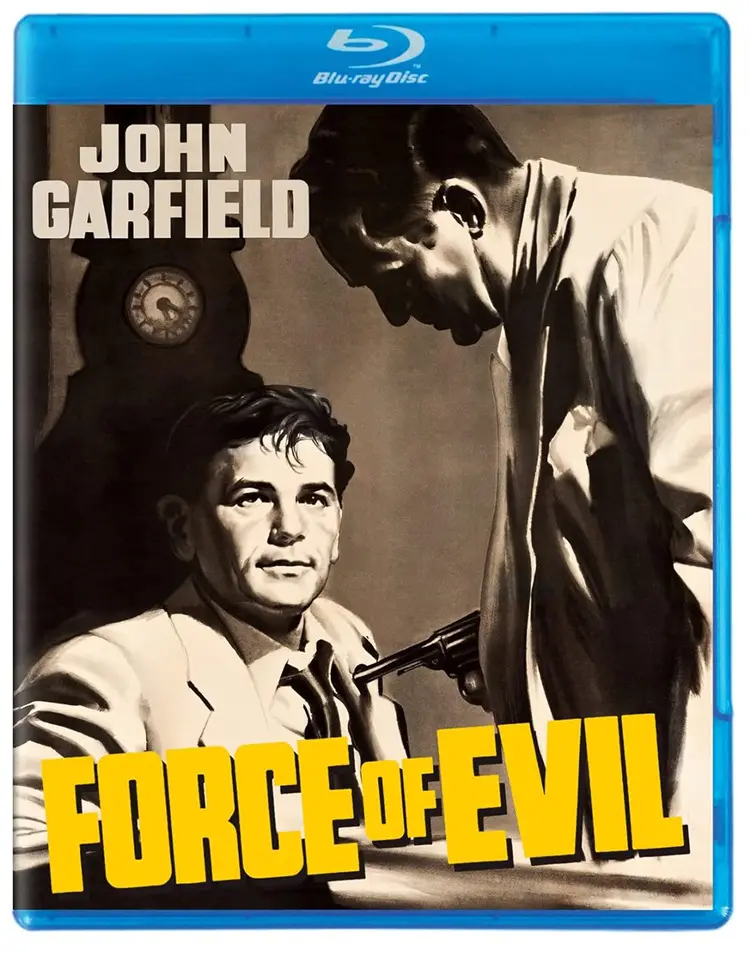
In the seemingly endless discourse on social media about Martin Scorsese versus the MCU, one side seems to turn Scorsese into some elitist snob who only likes pretentious, artsy-fartsy films that you need a graduate degree in film studies even to understand. But that’s not even remotely true. Scorsese’s own films are mostly easily accessible. Goodfellas is one of the most endlessly entertaining movies ever made. He’s praised the likes of Sam Raimi and John Carpenter. Through his Film Foundation organization, he’s restored hundreds of films including genre fare like The Enforcer with Humphrey Bogart and the 1973 horror film Ganja & Hess.
In his introduction to Force of Evil included on the new Blu-ray from Kino Lorber, Scorsese notes how influential the film was to him, and how it was an inspiration to him while making Raging Bull. As is his way, Scorsese digs deep into the film’s many themes, making it sound like an art film, but at its heart Force of Evil is a B-picture, a crime drama. A film noir. A great one at that, but it has no pretensions.
John Garfield, in perhaps his best performance, stars as Joe Morse, a lawyer whose biggest client is Ben Tucker (Roy Roberts), a gangster who runs the numbers racket in New York City. Joe has an idea that will consolidate the racket making he and Tucker rich. The numbers racket is a bit too complicated to get into in this review, but basically, people all over the city make bets on a number that will be posted in the next day’s newspaper. That number comes from the previous day’s racetrack bets. The bets are made through bookies and financed through underground “banks.” The banks send a percentage of their winnings to Tucker and keep a slice for themselves. Joe plans to fix the numbers on a certain day by having someone place enough bets to make that day’s number come out a certain way. Every July 4th, thousands of people bet on “776” as a sort of superstition. Usually, they lose, but if Joe can fix it so that they win, then many of the banks will go broke. At that point, Tucker can sweep in, take control of all the banks, and make a killing in the process.
The trouble is Joe’s brother, Leo (Thomas Gomez), runs one of those banks. He’s a straight-shooter. Sure, he works in an illegal business, but he’s always up-front with everybody and he treats his employees well. He’s the type of guy who finds ways to justify what he’s doing. Joe has no such qualms. At one point, he says, “I didn’t have enough strength to resist corruption, but I was strong enough to fight for a piece of it.” He thinks his brother is the same, but has to be pushed into it, he has to be forced into evil if you will.
Like the story of Cain and Abel, Force of Evil is a tale about brothers. Leo was supposed to have been the lawyer. He could have done great things. But when their parents died, he had to work and support Joe. Now Joe’s working for gangsters and dragging Leo into it. There is a line in the middle of the film, that’s almost tossed off, in which Leo talks about how he used to have legitimate business – real estate and a garage. But there are no legitimate businesses; he had to steal credit in real estate, and overcharge for the gas. Capitalism is a corrupt system. But Leo doesn’t like it, whereas Joe has come to accept it, even enjoy it.
When Joe tries to tell Leo about what he’s going to do, how he’s going to fix the numbers racket and wants to let him in on it, Leo pushes back. That’s one step too far for him. He can’t do it, even if the alternative is bankruptcy. There is a girl who works as a secretary for Leo, Doris (Beatrice Pearson). He treats her like a daughter. She works as the film’s moral center. Joe takes a shine to her and nearly corrupts her, but she manages to stay clean by the end.
Above both brothers is Tucker, an unstoppable force. A man who is always there, pushing the buttons, making his money. Ready to use force and violence to get what he wants.
Force of Evil was a studio film. It had to work within the confines of its own unstoppable force – MGM Studios. It is a B-movie, a cheap crime drama. But it is also a morality tale. One whose deep themes still resonate today. It is a film I’ve been chewing on since I watched it. I’ll still be chewing on it tomorrow. Garfield’s performance is wonderful. His face is a palette of emotion. Here’s a man who has set his path and is okay with it, but he loves his brother, is jealous of him even. And he wants to do right by him. Thomas Gomez is fantastic as well. He has moral righteousness on his side, but he knows too that he’s also set his path down in those corrupt waters. This was Abraham Polansky’s first film as a director. Due to falling afoul of the House of Un-American Activities Committee, he wouldn’t direct another one until Tell Them Willie Boy Is Here in 1969. That’s a loss to cinema, as he made an incredible film with this one.
Maybe Martin Scorsese was right, this is an art film.
UCLA and the Film Foundation restored Force of Evil in 2022. Kino Lorber presents this restored version with in a beautiful looking 1080p definition. Extras include an audio commentary Imogen Sara Smith and the aforementioned archival introduction by Scorsese.